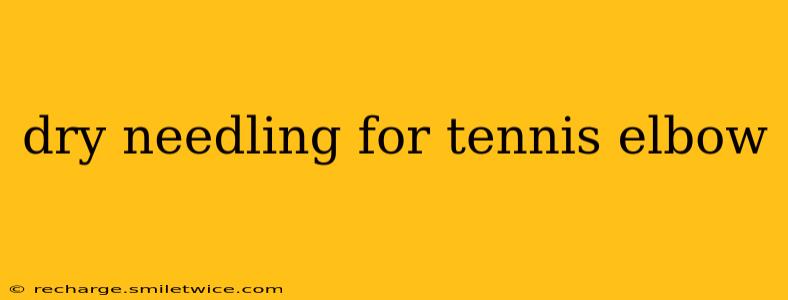Tennis elbow, also known as lateral epicondylitis, is a painful condition affecting the outside of the elbow. It's characterized by inflammation of the tendons that connect the forearm muscles to the elbow. While rest, ice, and physical therapy are common treatments, dry needling has emerged as a potentially effective addition to the therapeutic arsenal. This comprehensive guide explores the use of dry needling for tennis elbow, addressing common questions and concerns.
What is Dry Needling?
Dry needling is a technique used by physical therapists and other healthcare professionals to treat musculoskeletal pain. It involves inserting thin, solid needles into the skin and underlying muscle tissue at specific trigger points. These trigger points are areas of tight, taut bands of muscle fibers that can contribute to pain and restricted movement. Unlike acupuncture, dry needling doesn't focus on energy meridians; instead, it targets the myofascial system – the muscles and the connective tissue that surrounds them. The insertion of the needle aims to release these trigger points, reducing pain and improving muscle function.
How Does Dry Needling Help with Tennis Elbow?
The pain associated with tennis elbow often originates from the extensor carpi radialis brevis (ECRB) muscle, located on the outer side of the forearm. Dry needling targets this muscle, aiming to:
- Reduce muscle tension: The needles help release tension within the ECRB muscle, alleviating the strain on the tendon attachment at the elbow.
- Decrease inflammation: The process can stimulate the body's natural healing mechanisms, reducing inflammation in the affected area.
- Improve blood flow: Needling can improve circulation to the area, facilitating tissue repair and reducing pain.
- Restore muscle function: By releasing trigger points and reducing pain, dry needling promotes improved range of motion and strength in the forearm.
Is Dry Needling for Tennis Elbow Painful?
The sensation during dry needling varies from person to person. Some individuals report a mild pinching or aching sensation as the needle is inserted, while others experience no discomfort. A qualified practitioner will use techniques to minimize discomfort. Any residual soreness after the treatment is typically mild and short-lived.
How Many Dry Needling Sessions Are Needed for Tennis Elbow?
The number of dry needling sessions required for tennis elbow varies depending on the individual's condition, response to treatment, and other contributing factors. Some individuals may experience significant relief after just one or two sessions, while others may require a course of several treatments. Your physical therapist will create a personalized treatment plan based on your specific needs.
What are the Risks and Side Effects of Dry Needling for Tennis Elbow?
Dry needling is generally considered safe when performed by a qualified and experienced practitioner. However, potential risks and side effects include:
- Bleeding or bruising: Minor bleeding or bruising at the needle insertion site is possible.
- Infection: The risk of infection is minimal if proper sterilization techniques are followed.
- Nerve damage: This is a rare complication, but it can occur if the needle inadvertently damages a nerve. This risk is significantly reduced with proper technique and practitioner skill.
It's crucial to choose a licensed and experienced practitioner to minimize these risks.
Does Dry Needling Work Better Than Other Treatments for Tennis Elbow?
Dry needling is not a standalone treatment for tennis elbow. It's often used in conjunction with other therapies, such as physical therapy exercises, stretching, and rest. Research on the effectiveness of dry needling for tennis elbow is ongoing, but studies suggest it can be a valuable addition to a comprehensive treatment plan. The overall effectiveness depends on individual factors and the combination of therapies used.
Dry Needling vs. Other Tennis Elbow Treatments: Which is Best?
The "best" treatment for tennis elbow depends on the individual and the severity of their condition. Other common treatments include:
- Rest and ice: Reducing activity and applying ice to the elbow can help reduce pain and inflammation.
- Physical therapy: This involves exercises to strengthen the forearm muscles and improve range of motion.
- Corticosteroid injections: These injections can provide temporary pain relief, but they are not a long-term solution.
- Surgery: In rare cases, surgery may be necessary to repair severely damaged tendons.
A healthcare professional can help determine the most appropriate treatment plan based on a thorough assessment of your condition.
Conclusion
Dry needling can be a valuable tool in the management of tennis elbow pain, but it's crucial to remember that it's most effective as part of a broader treatment strategy. Choosing a qualified and experienced practitioner is paramount to ensure safety and optimal results. Always consult with your doctor or physical therapist to discuss if dry needling is the right treatment option for you.
